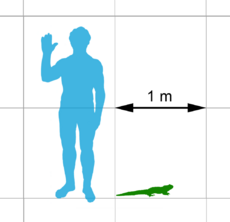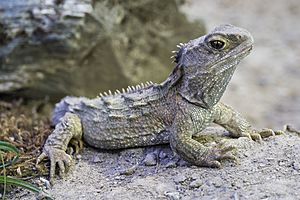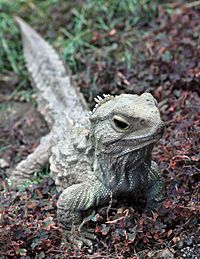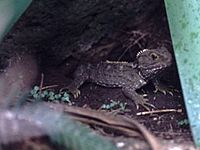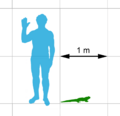Tuatara facts for kids
Quick facts for kids Tuatara |
|
|---|---|
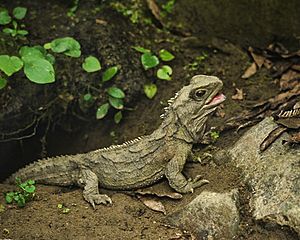 |
|
| Northern tuatara (Sphenodon punctatus punctatus) | |
| Conservation status | |
|
Invalid status (NZ TCS)
|
|
| Scientific classification | |
| Genus: |
Sphenodon
|
| Species: |
punctatus
|
 |
|
| Native range (New Zealand) | |
 |
|
| Current distribution of tuatara (in black): Circles represent the North Island tuatara, and squares the Brothers Island tuatara. Symbols may represent up to seven islands. | |
| Synonyms | |
|
|
Tuatara (Sphenodon punctatus) are reptiles endemic to New Zealand.
Contents
Name
The name tuatara is derived from the Māori language and means "peaks on the back".
Description
Adult S. punctatus males measure 61 cm (24 in) in length and females 45 cm (18 in). Tuatara are sexually dimorphic, males being larger. The San Diego Zoo even cites a length of up to 80 cm (31 in). Males weigh up to 1 kg (2.2 lb), and females up to 0.5 kg (1.1 lb). Brother's Island tuatara are slightly smaller, weighing up to 660 g (1.3 lb).
Their lungs have a single chamber with no bronchi.
They have two rows of teeth in the upper jaw overlapping one row on the lower jaw, which is unique among living species. They are able to hear, although no external ear is present, and have unique features in their skeleton, some of them apparently evolutionarily retained from fish. This mechanism allows the jaws to shear through chitin and bone. Fossils indicate that the jaw mechanism began evolving at least 200 million years ago. The teeth are not replaced. As their teeth wear down, older tuatara have to switch to softer prey such as earthworms, larvae, and slugs, and eventually have to chew their food between smooth jaw bones.
The tuatara's greenish brown colour matches its environment, and can change over its lifetime. Tuatara shed their skin at least once per year as adults, and three or four times a year as juveniles. Tuatara sexes differ in more than size. The spiny crest on a tuatara's back, made of triangular, soft folds of skin, is larger in males, and can be stiffened for display. The male abdomen is narrower than the female's.
Behaviour
Adult tuatara are terrestrial and nocturnal reptiles. However, they often bask in the sun to warm their bodies.
Hatchlings hide under logs and stones, and are diurnal, likely because adults are cannibalistic. Juveniles are typically active at night, but can be found active during the day. Tuatara live in temperatures much lower than those tolerated by most reptiles, and hibernate during winter. They remain active at temperatures as low as 5 °C (41 °F), while temperatures over 28 °C (82 °F) are generally fatal. The optimal body temperature for the tuatara is from 16 to 21 °C (61 to 70 °F), the lowest of any reptile. The body temperature of tuatara is lower than that of other reptiles, ranging from 5.2–11.2 °C (41.4–52.2 °F) over a day, whereas most reptiles have body temperatures around 20 °C (68 °F). The low body temperature results in a slower metabolism.
Habitat and diet
Burrowing seabirds such as petrels, prions, and shearwaters share the tuatara's island habitat during the birds' nesting seasons. The tuatara use the birds' burrows for shelter when available, or dig their own.
The seabirds' guano helps to maintain invertebrate populations on which tuatara predominantly prey; including beetles, crickets, spiders, wētās, earthworms, and snails. Their diets also consist of frogs, lizards, and bird's eggs and chicks. Young tuatara are also occasionally cannibalized.
The diet of the tuatara varies seasonally and they mainly only consume fairy prions and their eggs in the summer. The eggs and young of seabirds that are seasonally available as food for tuatara may provide beneficial fatty acids.
Reproduction
Tuatara reproduce very slowly. It takes them 10 to 20 years to reach sexual maturity.
Mating occurs in midsummer; females mate and lay eggs once every four years. During courtship, a male makes his skin darker, raises his crests, and parades toward the female. He slowly walks in circles around the female with stiffened legs.
It takes the females between one and three years to provide eggs with yolk, and up to seven months to form the shell. Hatchlings appear within 12 and 15  months. This means reproduction occurs at two- to five-year intervals, the slowest in any reptile. Wild tuatara are known to be still reproducing at about 60 years of age; "Henry", a male tuatara at Southland Museum in Invercargill, New Zealand, became a father (possibly for the first time) on 23 January 2009, at age 111, with an 80 year-old female.
The sex of a hatchling depends on the temperature of the egg. Warmer eggs produce male tuatara, and cooler eggs produce females. Eggs incubated at 21 °C (70 °F) have an equal chance of being male or female. Some evidence indicates sex determination in tuatara is determined by both genetic and environmental factors. Since global temperatures are increasing faster than ever, researchers are worried that in a few decades tuatara offspring populations will be all male.
Conservation
The tuatara (Sphenodon punctatus) has been protected by law since 1895. Tuatara, like many of New Zealand's native animals, are threatened by habitat loss and introduced predators, such as the Polynesian rat (Rattus exulans). Tuatara were extinct on the mainland, with the remaining populations confined to 32 offshore islands until the first North Island release into the heavily fenced and monitored Karori Wildlife Sanctuary (now named "Zealandia") in 2005.
Prior to conservation work, 25% of the distinct tuatara populations had become extinct in the past century. The total population of tuatara is estimated to be between 60,000 and 100,000.
During routine maintenance work at Zealandia in late 2008, a tuatara nest was uncovered, with a hatchling found the following autumn. This is thought to be the first case of tuatara successfully breeding in the wild on New Zealand's North Island in over 200 years.
Captive breeding
The first successful breeding of tuatara in captivity is believed to have achieved by Sir Algernon Thomas at either his University offices or residence in Symonds Street in the late 1880s or his new home, Trewithiel, in Mount Eden in the early 1890s.
Several tuatara breeding programmes are active in New Zealand. Southland Museum and Art Gallery in Invercargill was the first institution to have a tuatara breeding programme; starting in 1986 they bred S. punctatus and have focused on S. guntheri more recently.
Hamilton Zoo, Auckland Zoo and Wellington Zoo also breed tuatara for release into the wild. The Victoria University of Wellington maintains a research programme into the captive breeding of tuatara, and the Pukaha / Mount Bruce National Wildlife Centre keeps a pair and a juvenile.
The WildNZ Trust has a tuatara breeding enclosure at Ruawai. One notable captive breeding success story took place in January 2009, when all 11 eggs belonging to 110 year-old tuatara Henry and 80 year-old tuatara Mildred hatched. This story is especially remarkable as Henry required surgery to remove a cancerous tumour in order to successfully breed.
In January 2016, Chester Zoo, England, announced that they succeeded in breeding the tuatara in captivity for the first time outside its homeland.
Cultural significance
Tuatara feature in a number of indigenous legends, and are held as ariki (God forms). Tuatara are regarded as the messengers of Whiro, the god of death and disaster, and Māori women are forbidden to eat them. Tuatara also indicate tapu (the borders of what is sacred and restricted), beyond which there is mana, meaning there could be serious consequences if that boundary is crossed. Māori women would sometimes tattoo images of lizards, some of which may represent tuatara. Today, tuatara are regarded as a taonga (special treasure) along with being viewed as the kaitiaki (guardian) of knowledge.
The tuatara was featured on one side of the New Zealand five-cent coin, which was phased out in October 2006. Tuatara was also the name of the Journal of the Biological Society of Victoria University College and subsequently Victoria University of Wellington, published from 1947 until 1993. It has now been digitised by the New Zealand Electronic Text Centre, also at Victoria.
Interesting facts about tuatara
- Although it looks like a lizard, tuatara is a different species, part of the order Rhynchocephalia.
- The closest living relatives of tautara are squamates (lizards and snakes).
- The tuatara shares with lizards the ability to break off its tail when caught by a predator, and then regenerate it. The regrowth takes a long time and differs from that of lizards.
- The ancestors of tuatara were related to dinosaurs (including birds) and crocodilians.
- Tuatara have preserved the morphological characteristics of their Mesozoic ancestors (240–230 million years ago) and are sometimes referred to as "living fossils".
- The species has between 5 and 6 billion base pairs of DNA sequence, nearly twice that of humans.
- Tuatara are the largest reptile in New Zealand.
- The animal has a third eyelid on each eye and has a good colour vision, possibly even at low light levels.
- The tuatara has a third eye on the top of its head called the parietal eye. It is visible only in hatchlings; after four to six months, it becomes covered with opaque scales and pigment.
- Tuataras have no eardrum and no earhole. However, they respond to frequences from 100 to 800 Hz.
- The tuatara has several hundred odorant receptors, around 472, a number more similar to what birds have than to the large number of receptors that turtles and crocodiles may have.
- The tuatara's lifespan is much longer than 35 years (ages up to 60 are common, and captive tuatara have lived to over 100 years); tuatara could be the reptile with the second longest lifespan after tortoises.
- Some experts believe that captive tuatara could live as long as 200 years.
- Tuataras defend territories, and will threaten and eventually bite intruders. The bite can cause serious injury. Tuatara will bite when approached, and will not let go easily.
- Tuataras are parasitised by the tuatara tick (Archaeocroton sphenodonti), a tick that depends on tuataras.
Images for kids
See also
 In Spanish: Sphenodon para niños
In Spanish: Sphenodon para niños



